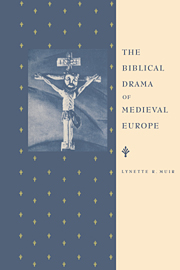Book contents
- Frontmatter
- Contents
- List of illustrations
- Preface
- Acknowledgements
- List of abbreviations
- Map 1 Medieval Europe showing locations of principal play-texts and records cited in this study
- Map 2 Enlargement of central area showing locations of liturgical and feast-day plays as defined in chapter 1
- Map 3 Enlargement of central area showing locations of civic and community plays as defined in chapter 2
- Introduction: Christian Europe and the Play of God
- PART ONE THE THEATRICAL COMMUNITY
- PART TWO THE THEATRICAL TEXT
- Conclusion: survival and revival
- Appendix: the liturgical context of the plays
- Notes
- Bibliographical index of plays
- Performance records and references
- General bibliography
- Index
Introduction: Christian Europe and the Play of God
Published online by Cambridge University Press: 18 September 2009
- Frontmatter
- Contents
- List of illustrations
- Preface
- Acknowledgements
- List of abbreviations
- Map 1 Medieval Europe showing locations of principal play-texts and records cited in this study
- Map 2 Enlargement of central area showing locations of liturgical and feast-day plays as defined in chapter 1
- Map 3 Enlargement of central area showing locations of civic and community plays as defined in chapter 2
- Introduction: Christian Europe and the Play of God
- PART ONE THE THEATRICAL COMMUNITY
- PART TWO THE THEATRICAL TEXT
- Conclusion: survival and revival
- Appendix: the liturgical context of the plays
- Notes
- Bibliographical index of plays
- Performance records and references
- General bibliography
- Index
Summary
Passion plays and Corpus Christi cycles, like Arthurian romances and Gothic cathedrals, are among the outstanding cultural monuments of medieval Europe. However, theatre is an essentially evanescent art form: texts and records can provide at best a skeleton of the drama which, for a brief moment, combined the verbal, musical and visual arts with the beliefs and faith of Christendom. The medieval bones of this body are plentiful and widely dispersed: play-texts and records of performances; accounts, costume lists, contracts and minutes of town meetings; contemporary reports and eye-witness descriptions. All these survive in their hundreds, for biblical drama flourished in Western Catholic Europe for more than five hundred years and its roots go back to the very beginnings of Christianity.
Like Judaism, Christianity had at its core a regular ceremonial reenactment of the saving activity of God. Under the Old Covenant, Moses instructed the children of Israel in the annual commemoration of the Passover: ‘You shall observe the rite as an ordinance for you and your sons for ever’ (Exodus 12: 24). Christ took this Law and reinterpreted it in the form of the New Covenant, bidding his disciples: ‘Do this in remembrance of me.’ From the earliest centuries the Christian Church obeyed his commandment through the celebration of the sacrament of the Mass.
- Type
- Chapter
- Information
- The Biblical Drama of Medieval Europe , pp. 1 - 10Publisher: Cambridge University PressPrint publication year: 1995



